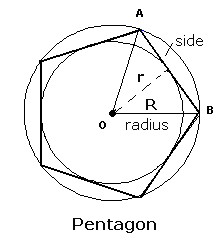Regular polygon
A polygon is regular when all the sides and interior angles are equal, otherwise it is "irregular". The polygons are known by the number
of sides. See below some examples of Regular Polygon:
1) Tetragon, 4 sided polygon;
2) Pentagon, 5 sided polygon;
3) Hexagon, 6 sided polygon;
4) Heptagon, 7-sided polygon;
Some elements of polygons:
Vertex: point where two sides of the polygon intersect;
Diagonal: a line segment connecting two non-adjacent vertices;
Longest diagonal: diameter of circumscribed circle;
Angle: aperture of two adjacent segments that meet in a vertices;
Circumscribed circle: circle that touches all the vertices of the polygon;
Inscribed circle: circle that touches on all the midpoints of the sides of the polygon;
Radius: distances from the center to any vertex or side midpoint;
Incircle radius polygon: a radius of inscribed circle of a polygon;
Excircle radius polygon: a radius of circumscribed circle of a polygon;
Incenter : The center of the incircle;
Apothem : A line segment connecting the incenter to the midpoint of a side. Circumscribed circle;
Interior Angles: the angles formed by each pair of adjacent sides;
Exterior Angles : angle formed by any side of a polygon and the extension of its adjacent side.
The sum of exterior angles is always equal to 360.
How to calculate the elements of Regular polygon.

Related Topics
Right Triangle Isosceles Triangle Equilateral Triangle Scalene Triangle Square Rectangle Trapezium Right-Angled Trapezoid Isosceles Trapezoid Rhombus Regular polygon Polygon names Circle Pyramid Triangle pyramid Square pyramid Rectangular pyramid Cube Prism Rectangle Prism Cone Cylinder Sphere



